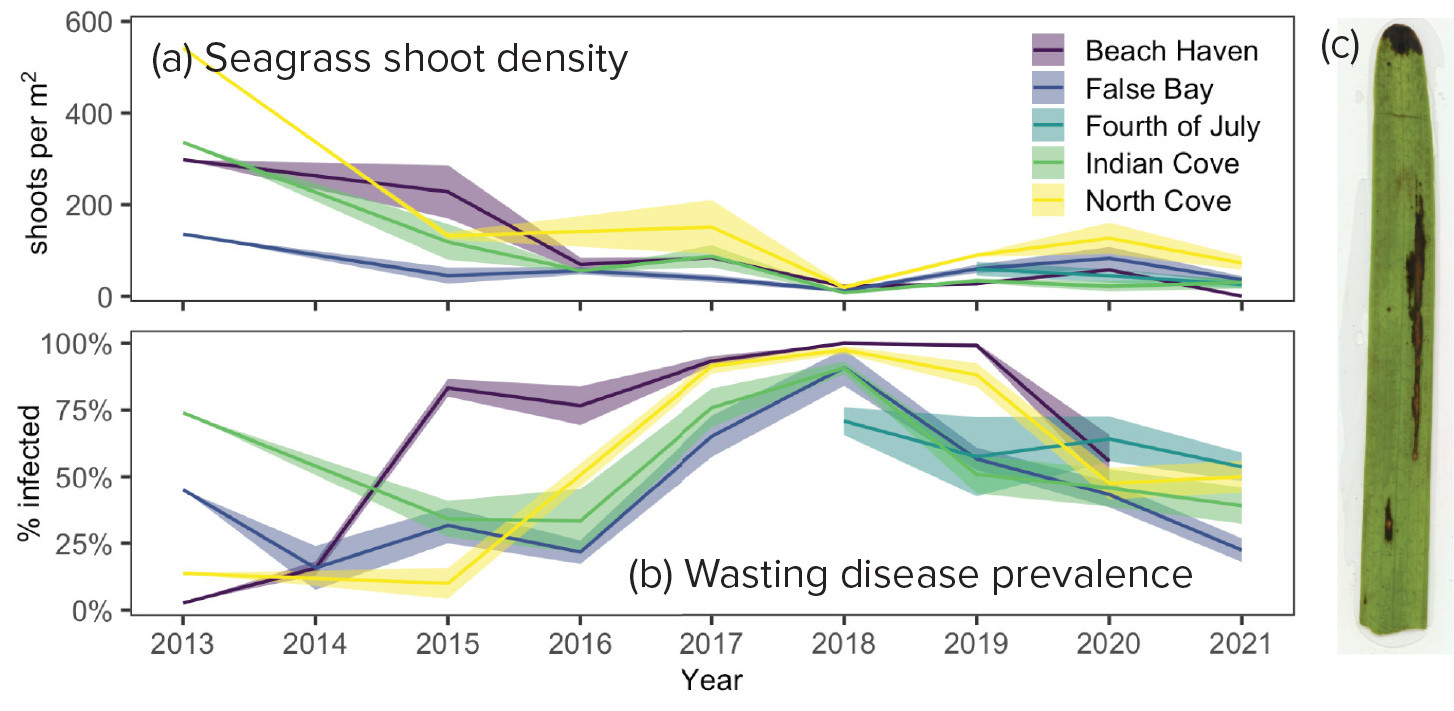Full Text
Seagrass meadows are essential habitats that support marine biodiversity and coastal communities while sequestering carbon, filtering water, and stabilizing coastal sediments. Warming temperatures stress seagrass meadows and can facilitate seagrass wasting disease, contributing to large-scale diebacks of seagrass meadows. Here, we demonstrate how high-resolution imagery, collected by uncrewed aerial vehicle (UAV) and validated by in situ sampling, can quantify seagrass responses to disease and thermal stress.
Seagrass meadows in the San Juan Islands, Washington, USA, have declined dramatically over the last decade. Shoot densities, measured along permanent monitoring transects, fell over 90% from 2013 to 2021, while wasting disease prevalence (percent infected plants) remained persistently above 40% since the 2016 Northeast Pacific heatwave (Figure 1). Since 2019, we have synchronized UAV surveys with midsummer in situ sampling. The UAV imagery greatly expands the scope of the data, extending beyond the monitoring transects to confirm large-scale loss of seagrass. Because this imagery can achieve 1–3 cm spatial resolution, analysis can connect individual plants (<3 cm) to ecosystem dynamics at the meadow scale (kilometers). The broad picture of seagrass decline detected in the UAV imagery reinforces the need for landscape-scale monitoring.
|
|
High-resolution imagery further provides insight into seagrass dynamics under climate change. Wasting disease is sensitive to warming, with infections increasing in warmer years (Groner et al., 2021). In June 2021, there was an unprecedented heating event in the study region (the 2021 Pacific Northwest heat dome). Daily sea surface temperatures exceeded the 90th percentile of long-term temperature records for 10 consecutive days (Figure 2). During this period, low tides occurred in early afternoon and the exposed intertidal meadows reached hourly temperatures as high as 34ºC at some sites, far exceeding the normal temperature range. These high temperatures cause physiological stress in seagrass, and prolonged exposure to high temperatures can cause plant mortality and rapid meadow diebacks. UAV imagery collected immediately following this event highlighted the dramatic loss of seagrass density and coverage for all monitoring sites, including the two sites shown here (Figure 3). At the Beach Haven site, the UAV imagery showed the nearly complete loss of the upper 10 m of seagrass between 2020 and 2021. This loss of habitat structure will have cascading ecological consequences, including reduced animal abundance, reduced carbon sequestration potential, and reduced shoreline protection. High levels of wasting disease infection in the years prior to this heatwave likely weakened these meadows, increasing their vulnerability to acute thermal stress and contributing to meadow-scale declines (Graham et al., 2021). Further quantification of spatiotemporal trends in patchiness, biomass, and plant health will show how climate-driven disturbance propagates across the landscape. Landscape-scale monitoring using UAV methods is increasingly urgent as the frequency, intensity, and duration of extreme heating events such as the 2021 heat dome increase under climate change.
|
|
|
|
In the dynamic intertidal zone, the flexibility of UAV methods could revolutionize assessment of disturbance trajectories (Yang et al., 2020). Because UAVs can be deployed rapidly, cross-scale imagery can be collected immediately after disturbance as well as at seasonal or annual intervals. Advanced methods such as deploying UAVs with multispectral, hyperspectral, or thermal sensors, combined with ground-sampled spectral signatures, can provide new insights into indicators of plant health, competition with macroalgae, and the presence of invasive species. The ongoing development of machine learning image processing algorithms will facilitate rapid and high-throughput image analysis and support managers and monitoring programs focused on understanding the real-time status and temporal dynamics of these ecosystems. With worsening wasting disease outbreaks and extreme heating under climate change, synergistic combinations of in situ and UAV methods are needed to understand seagrass meadow dynamics across spatial and temporal scales.




